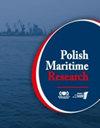Optimal UV Quantity for a Ballast Water Treatment System for Compliance with Imo Standards
IF 2
3区 工程技术
Q2 ENGINEERING, MARINE
引用次数: 0
Abstract
Abstract Ballast water management is an effective measure to ensure that organisms, bacteria and viruses do not migrate with the ballast water to other areas. In 2004, the International Maritime Organization adopted the International Convention on the Control and Management of Ballast Water and Ship Sediments, which regulates issues related to ballast water management. Many technologies have been researched and developed, and of these, the use of UV rays in combination with filter membranes has been shown to have many advantages and to meet the requirements of the Convention. However, the use of UV furnaces in ballast water treatment systems requires a very large capacity, involving the use of many high-power UV lamps. This not only consumes large amounts of electrical energy, but is also expensive. It is therefore necessary to find an optimal algorithm to enable the UV radiation for the UV controller in the ballast water sterilisation process to be controlled in a reasonable and effective manner. This controller helps to prolong the life of the UV lamp, reduce power consumption and ensure effective sterilisation. This paper presents a UV control algorithm and a controller for a UV furnace for a ballast water treatment system installed on a ship. The results of tests on vessels illustrate the effect of the proposed UV controller.符合伊莫标准的压载水处理系统的最佳紫外线用量
摘要 压载水管理是确保生物、细菌和病毒不会随压载水迁移到其他地区的有效措施。2004 年,国际海事组织通过了《控制和管理压载水和船舶沉积物国际公约》,对压载水管理的相关问题做出了规定。目前已研究和开发了许多技术,其中紫外线与过滤膜的结合使用已被证明具有许多优点,并能满足《公约》的要求。然而,在压载水处理系统中使用紫外线炉需要非常大的容量,涉及使用许多大功率紫外线灯。这不仅会消耗大量电能,而且价格昂贵。因此,有必要找到一种最佳算法,以合理有效地控制压舱水灭菌过程中紫外线控制器的紫外线辐射。这种控制器有助于延长紫外线灯的寿命、降低功耗并确保有效杀菌。本文介绍了一种紫外线控制算法和紫外线炉控制器,用于安装在船上的压舱水处理系统。在船上进行的测试结果表明了所提出的紫外线控制器的效果。
本文章由计算机程序翻译,如有差异,请以英文原文为准。
求助全文
约1分钟内获得全文
求助全文
来源期刊

Polish Maritime Research
工程技术-工程:海洋
CiteScore
3.70
自引率
45.00%
发文量
20
审稿时长
>12 weeks
期刊介绍:
The scope of the journal covers selected issues related to all phases of product lifecycle and corresponding technologies for offshore floating and fixed structures and their components.
All researchers are invited to submit their original papers for peer review and publications related to methods of the design; production and manufacturing; maintenance and operational processes of such technical items as:
all types of vessels and their equipment,
fixed and floating offshore units and their components,
autonomous underwater vehicle (AUV) and remotely operated vehicle (ROV).
We welcome submissions from these fields in the following technical topics:
ship hydrodynamics: buoyancy and stability; ship resistance and propulsion, etc.,
structural integrity of ship and offshore unit structures: materials; welding; fatigue and fracture, etc.,
marine equipment: ship and offshore unit power plants: overboarding equipment; etc.
 求助内容:
求助内容: 应助结果提醒方式:
应助结果提醒方式:


